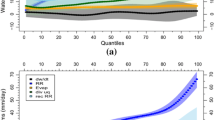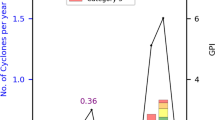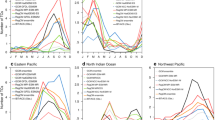Abstract
This study examines the climatology and structure of rainfall associated with tropical cyclones (TCs) based on the atmosphere-only Coupled Model Intercomparison Project Phase 6 (CMIP6) HighResMIP runs of the PRocess-based climate sIMulation: AdVances in high resolution modelling and European climate Risk Assessment (PRIMAVERA) Project during 1979–2014. We evaluate how the spatial resolution of climate models with a variety of dynamic cores and parameterization schemes affects the representation of TC rainfall. These HighResMIP atmosphere-only runs that prescribe historical sea surface temperatures and radiative forcings can well reproduce the observed spatial pattern of TC rainfall climatology, with high-resolution models generally performing better than the low-resolution ones. Overall, the HighResMIP atmosphere-only runs can also reproduce the observed percentage contribution of TC rainfall to total amounts, with an overall better performance by the high-resolution models. The models perform better over ocean than over land in simulating climatological total TC rainfall, TC rainfall proportion and TC rainfall per TC in terms of spatial correlation. All the models in the HighResMIP atmosphere-only runs underestimate the observed composite TC rainfall structure over both land and ocean, especially in their lower resolutions. The underestimation of rainfall composites by the HighResMIP atmosphere-only runs is also supported by the radial profile of TC rainfall. Overall, the increased spatial resolution generally leads to an improved model performance in reproducing the observed TC rainfall properties.












Similar content being viewed by others
References
Abdalla O, Al-Abri RY (2011) Groundwater recharge in arid areas induced by tropical cyclones: lessons learned from Gonu 2007 in Sultanate of Oman. Environ Earth Sci 63:229–239. https://doi.org/10.1007/s12665-010-0688-y
Aryal YN, Villarini G, Zhang W, Vecchi GA (2018) Long term changes in flooding and heavy rainfall associated with North Atlantic tropical cyclones: roles of the North Atlantic Oscillation and El Niño-Southern Oscillation. J Hydrol 559:698–710
Bao X, Wu D, Lei X, Ma L, Wang D, Zhao K, Jou BJ-D (2017) Improving the extreme rainfall forecast of Typhoon Morakot (2009) by assimilating radar data from Taiwan Island and mainland China. J Meteorol Res 31:747–766
Barlow M (2011) Influence of hurricane-related activity on North American extreme precipitation. Geophys Res Lett 38:L04705
Beck HE et al (2017) Global-scale evaluation of 22 precipitation datasets using gauge observations and hydrological modeling. Hydrol Earth Syst Sci 21:6201
Beck HE, Van Dijk AI, Levizzani V, Schellekens J, Gonzalez Miralles D, Martens B, De Roo A (2017) MSWEP: 3-hourly 0.25 global gridded precipitation (1979–2015) by merging gauge, satellite, and reanalysis data. Hydrol Earth Syst Sci 21:589–615
Bosma CD, Wright DB, Nguyen P, Kossin JP, Herndon DC, Shepherd JM (2020) An intuitive metric to quantify and communicate tropical cyclone rainfall hazard. Bull Am Meteorol Soc 101:E206–E220
Bucknam RC, Coe JA, Chavarria MM, Godt JW, Tarr AC, Johnson ML et al (2001). Landslides triggered by Hurricane Mitch in Guatemala—inventory and discussion. USGS Report Number 2001-443
Caron L-P, Jones CG, Winger K (2011) Impact of resolution and downscaling technique in simulating recent Atlantic tropical cyclone activity. Climate Dyn 5:869–892. https://doi.org/10.1007/s00382-010-0846-7
Chen SS, Knaff JA, Marks FD Jr (2006) Effects of vertical wind shear and storm motion on tropical cyclone rainfall asymmetries deduced from TRMM. Mon Weather Rev 134:3190–3208
Cherchi A et al (2019) Global mean climate and main patterns of variability in the CMCC-CM2 coupled model. J Adv Model Earth Syst 11:185–209
Corbosiero KL, Molinari J (2003) The relationship between storm motion, vertical wind shear, and convective asymmetries in tropical cyclones. J Atmos Sci 60:366–376
Czajkowski J, Villarini G, Montgomery M, Michel-Kerjan E, Goska R (2017) Assessing current and future freshwater flood risk from North Atlantic tropical cyclones via insurance claims. Sci Rep 7:1–10
Daloz AS, Chauvin F, Roux F (2010) Tropical cyclone rainfall in the observations, reanalysis and ARPEGE simulations in the North Atlantic Basin. In: Hurricanes and climate change. Springer, pp 57–79
Dare RA, Davidson NE, McBride JL (2012) Tropical cyclone contribution to rainfall over Australia. Mon Weather Rev 140:3606–3619
DeHart JC, Houze RA Jr (2017) Orographic modification of precipitation processes in Hurricane Karl (2010). Mon Weather Rev 145:4171–4186
EC-Earth Consortium (EC-Earth) (2018a) EC-Earth-858 Consortium EC-Earth3P model output prepared for CMIP6 HighResMIP. Earth System Grid Federation. http://cera860www.dkrz.de/WDCC/meta/CMIP6/CMIP6.HighResMIP.EC-Earth-Consortium.EC861Earth3P
EC-Earth Consortium (EC-Earth) (2018b) EC-Earth-Consortium EC-Earth3P-HR model output prepared for CMIP6 HighResMIP. Earth System Grid Federation. http://cera-www.dkrz.de/WDCC/meta/CMIP6/CMIP6.HighResMIP.EC-Earth-Consortium.EC-Earth3P-HR
Emanuel K (2017) Assessing the present and future probability of Hurricane Harvey’s rainfall. Proc Natl Acad Sci 114:12681–12684
Eyring V, Bony S, Meehl GA, Senior CA, Stevens B, Stouffer RJ, Taylor KE (2016) Overview of the coupled model intercomparison project phase 6 (CMIP6) experimental design and organization. Geosci Model Dev 9:1937–1958
Gates WL et al (1999) An overview of the results of the Atmospheric Model Intercomparison Project (AMIP I). Bull Am Meteorol Soc 80:29–56
Gutjahr O et al (2019) Max Planck Institute Earth System Model (MPI-ESM1.2) for the High-Resolution Model Intercomparison Project (HighResMIP). Geosci Model Dev 12:3241–3281
Haarsma RJ et al (2016) High Resolution Model Intercomparison Project (HighResMIP v1.0) for CMIP6. Geosci Model Dev 9:4185–4208
Hence DA, Houze RA Jr (2012) Vertical structure of tropical cyclone rainbands as seen by the TRMM Precipitation Radar. J Atmos Sci 69:2644–2661
Hodges K, Cobb A, Vidale PL (2017) How well are tropical cyclones represented in reanalysis datasets? J Climate 30:5243–5264
Janapati J et al (2020) Raindrop size distribution characteristics of Indian and Pacific ocean tropical cyclones observed at India and Taiwan Sites. J Meteorol Soc Japan Ser II
Jiang H, Zipser EJ (2010) Contribution of tropical cyclones to the global precipitation from eight seasons of TRMM data: Regional, seasonal, and interannual variations. J Climate 23:1526–1543
Jiang H, Liu C, Zipser EJ (2011) A TRMM-based tropical cyclone cloud and precipitation feature database. J Appl Meteorol Climatol 50:1255–1274
Kam J, Sheffield J, Yuan X, Wood EF (2013) The influence of Atlantic Tropical cyclones on drought over the Eastern US (1980–2007). J Climate 26(10):3067–3086
Khouakhi A, Villarini G, Vecchi GA (2017) Contribution of tropical cyclones to rainfall at the global scale. J Climate 30:359–372
Kim D et al (2018) Process-oriented diagnosis of tropical cyclones in high-resolution GCMs. J Climate 31:1685–1702
Klotzbach PJ, Bowen SG, Pielke R Jr, Bell M (2018) Continental US hurricane landfall frequency and associated damage: observations and future risks. Bull Am Meteorol Soc 99(7):1359–1376
Knapp KR, Kruk MC, Levinson DH, Diamond HJ, Neumann CJ (2010) The International Best Track Archive for Climate Stewardship (IBTrACS). Bull Am Meteorol Soc 91:363–376
Knight DB, Davis RE (2009) Contribution of tropical cyclones to extreme rainfall events in the southeastern United States. J Geophys Res Atmos 114
Lin Y, Zhao M, Zhang M (2015) Tropical cyclone rainfall area controlled by relative sea surface temperature. Nat Commun 6:1–7
Liu M, Vecchi GA, Smith JA, Murakami H (2018) Projection of landfalling–tropical cyclone rainfall in the Eastern United States under anthropogenic warming. J Climate 31:7269–7286
Liu M, Vecchi GA, Smith JA, Knutson TR (2019) Causes of large projected increases in hurricane precipitation rates with global warming. NPJ Climate Atmos Sci 2:38
Luitel B, Villarini G, Vecchi GA (2018) Verification of the skill of numerical weather prediction models in forecasting rainfall from U.S. landfalling tropical cyclones. J Hydrol 556:1026–1037
Manganello JV et al (2012) Tropical cyclone climatology in a 10-km global atmospheric GCM: toward weather-resolving climate modeling. J Climate 25:3867–3893
Miniussi A, Villarini G, Marani M (2020) Analyses through the metastatistical extreme value distribution identify contributions of tropical cyclones to rainfall extremes in the eastern US. Geophys Res Lett 47(7):1–9 (2020GL087238)
Moon Y et al (2020) Azimuthally averaged wind and thermodynamic structures of tropical cyclones in global climate models and their sensitivity to horizontal resolution. J Climate 33:1575–1595
Murakami H et al (2015) Simulation and prediction of category 4 and 5 hurricanes in the high-resolution GFDL HiFLOR coupled climate model. J Climate 28:9058–9079
Nguyen LT, Rogers RF, Reasor PD (2017) Thermodynamic and kinematic influences on precipitation symmetry in sheared tropical cyclones: Bertha and Cristobal (2014). Mon Weather Rev 145:4423–4446
NOAA National Centers for Environmental Information (NCEI) (2020) U.S. Billion-Dollar Weather and Climate Disasters. https://www.ncdc.noaa.gov/billions/. https://doi.org/10.25921/stkw-7w73
Peduzzi P, Chatenoux B, Dao H, De Bono A, Herold C, Kossin J, Mouton F, Nordbeck O (2012) Global trends in tropical cyclone risk. Nat Climate Change 2:289–294
Prat OP, Nelson BR (2013) Precipitation contribution of tropical cyclones in the southeastern United States from 1998 to 2009 using TRMM satellite data. J Climate 26:1047–1062
Prat OP, Nelson BR (2013) Mapping the world’s tropical cyclone rainfall contribution over land using the TRMM multi-satellite precipitation analysis. Water Resour Res 49:7236–7254
Prat OP, Nelson BR (2016) On the link between tropical cyclones and daily rainfall extremes derived from global satellite observations. J Climate 29:6127–6135
Rappaport EN (2014) Fatalities in the United States from Atlantic tropical cyclones, 2014: new data and interpretation. Bull Am Meteorol Soc 95(3):341–346
Reed KA, Standfield A, Wehner MF, Zarzycki CM (2018) The human influence on Hurricane Florence. Accessed Oct
Rios Gaona MF, Villarini G, Zhang W, Vecchi GA (2018) The added value of IMERG in characterizing rainfall in tropical cyclones. Atmos Res 209:95–102
Risser MD, Wehner MF (2017) Attributable human-induced changes in the likelihood and magnitude of the observed extreme precipitation during Hurricane Harvey. Geophys Res Lett 44:12457–12464
Roberts M (2017a) MOHC HadGEM3-GC31-LM model o 1008 utput prepared for CMIP6 HighResMIP. Version 20170906. Earth System Grid Federation. https://doi.org/10.22033/ESGF/CMIP6.1321
Roberts M (2017b) MOHC HadGEM3-GC31-MM model output prepared for CMIP6 HighResMIP. Version 20180818. Earth System Grid Federation. https://doi.org/10.22033/ESGF/CMIP6.1902
Roberts M (2017c) MOHC HadGEM3-GC31-HM model output prepared for CMIP6 HighResMIP. Version 20170831. Earth System Grid Federation. https://doi.org/10.22033/ESGF/CMIP6.446
Roberts MJ (2019) CMIP6 HighResMIP: tropical storm tracks as calculated by the TRACK algorithm. Centre for Environmental Data Analysis. http://catalogue.ceda.ac.uk/uuid/0b42715a7a804290afa9b7e31f5d7753
Roberts MJ et al (2015) Tropical cyclones in the UPSCALE ensemble of high-resolution global climate models. J Climate 28:574–596
Roberts CD, Senan R, Molteni F, Boussetta S, Keeley S (2017a) ECMWF ECMWF-IFS-LR model output prepared for CMIP6 HighResMIP. Version 20170915. Earth System Grid Federation. https://doi.org/10.22033/ESGF/CMIP6.2463
Roberts CD, Senan R, Molteni F, Boussetta S, Keeley S (2017b) ECMWF ECMWF-IFS-HR model output prepared for CMIP6 HighResMIP. Version 20170915. Earth System Grid Federation. https://doi.org/10.22033/ESGF/CMIP6.2461
Roberts CD, Senan R, Molteni F, Boussetta S, Mayer M, Keeley SP (2018) Climate model configurations of the ECMWF-Integrated Forecasting System (ECMWF-IFS cycle 43r1) for HighResMIP. Geosci Model Dev 11:3681–3712
Roberts MJ et al (2019) Description of the resolution hierarchy of the global coupled HadGEM3-GC313-GC3.1 model as used in CMIP6 HighResMIP experiments. Geosci Model Dev 12:4999–5028
Roberts MJ et al (2020) Impact of model resolution on tropical cyclone simulation using the HighResMIP-PRIMAVERA multi-model ensemble. J Climate 33:2557–2583
Scoccimarro E, Gualdi S, Villarini G, Vecchi GA, Zhao M, Walsh K, Navarra A (2014) Intense precipitation events associated with landfalling tropical cyclones in response to a warmer climate and increased CO2. J Climate 27:4642–4654
Scoccimarro E, Bellucci A, Peano D (2017a) CMCC CMCC-CM2-HR4 model output prepared for CMIP6 HighResMIP. Version YYYYMMDD[1]. Earth System Grid Federation. https://doi.org/10.22033/ESGF/CMIP6.1359
Scoccimarro E, Bellucci A, Peano D (2017b) CMCC CMCC-CM2-VHR4 model output prepared for CMIP6 HighResMIP. Version YYYYMMDD[1]. Earth System Grid Federation. https://doi.org/10.22033/ESGF/CMIP6.1367
Scoccimarro E, Villarini G, Gualdi S, Navarra A, Vecchi G, Walsh K, Zhao M (2017c) Tropical cyclone rainfall changes in a warmer climate. In: Hurricanes and climate change. Springer, pp 243–255
Scoccimarro E, Gualdi S, Bellucci A, Peano D, Cherchi A, Vecchi GA, Navarra A (2020) The typhoon-induced drying of the Maritime Continent. PNAS. https://doi.org/10.1073/pnas.1915364117
Shepherd JM, Grundstein A, Mote TL (2007) Quantifying the contribution of tropical cyclones to extreme rainfall along the coastal southeastern United States. Geophys Res Lett 34
Tang X, Lee W-C, Bell M (2014) A squall-line-like principal rainband in Typhoon Hagupit (2008) observed by airborne Doppler radar. J Atmos Sci 71:2733–2746
Touma D, Stevenson S, Camargo SJ, Horton DE, Diffenbaugh NS (2019) Variations in the intensity and spatial extent of tropical cyclone precipitation. Geophys Res Lett 46:13992–14002
Trenberth KE, Davis CA, Fasullo J (2007) Water and energy budgets of hurricanes: case studies of Ivan and Katrina. J Geophys Res 112:D23106
Van Oldenborgh GJ et al (2017) Attribution of extreme rainfall from Hurricane Harvey, August 2017. Environ Res Lett 12:124009
Vanniere B et al (2020) The moisture budget of tropical cyclones: large scale environmental constraints and sensitivity to model horizontal resolution. J Climate 33:8457–8474
Vecchi GA et al (2019) Tropical cyclone sensitivities to CO2 doubling: roles of atmospheric resolution, synoptic variability and background climate changes. Climate Dyn 53:5999–6033
Villarini G, Denniston RF (2016) Contribution of tropical cyclones to extreme rainfall in Australia. Int J Climatol 36:1019–1025
Villarini G, Smith JA, Baeck ML, Marchok T, Vecchi GA (2011) Characterization of rainfall distribution and flooding associated with U.S. landfalling tropical cyclones: analyses of Hurricanes Frances, Ivan, and Jeanne (2004). J Geophys Res Atmos 116
Villarini G et al (2014a) Sensitivity of tropical cyclone rainfall to idealized global-scale forcings. J Climate 27:4622–4641
Villarini G, Goska R, Smith JA, Vecchi GA (2014b) North Atlantic tropical cyclones and U.S. flooding. Bull Am Meteorol Soc 95(9):1381–1388
Voldoire A (2017) CNRM-CERFACS CNRM-CM6-1-HR model output prepared for CMIP6 HighResMIP. Earth System Grid Federation. http://cera1098www.dkrz.de/WDCC/meta/CMIP6/CMIP6.HighResMIP.CNRM-CERFACS.CNRM1099CM6-1-HR
Voldoire A (2018) CNRM-CERFACS CNRM-1092 CM6-1 model output prepared for CMIP6 HighResMIP. Earth System Grid Federation. http://cera1094www.dkrz.de/WDCC/meta/CMIP6/CMIP6.HighResMIP.CNRM-CERFACS.CNRM1095CM6-1
Voldoire A et al (2019) Evaluation of CMIP6 DECK Experiments With CNRM-CM6-1. J Adv Model Earth Syst 11:2177–2213
von Storch J-S et al (2017) MPI-M MPI-ESM1.2-HR model output prepared for CMIP6 HighResMIP. Earth System Grid Federation. http://cera1105www.dkrz.de/WDCC/meta/CMIP6/CMIP6.HighResMIP.MPI-M.MPI-ESM1-2-HR
von Storch J-S et al (2019) MPI-M MPI-ESM1.2-XR model output prepared for CMIP6 HighResMIP. Earth System Grid Federation. http://cera1108www.dkrz.de/WDCC/meta/CMIP6/CMIP6.HighResMIP.MPI-M.MPI-ESM1-2-XR
Wang Y, Lee K-H, Lin Y, Levy M, Zhang R (2014) Distinct effects of anthropogenic aerosols on tropical cyclones. Nat Climate Change 4:368–373
Wang SS, Zhao L, Yoon J-H, Klotzbach P, Gillies RR (2018) Quantitative attribution of climate effects on Hurricane Harvey’s extreme rainfall in Texas. Environ Res Lett 13:054014
Wehner MF et al (2014) The effect of horizontal resolution on simulation quality in the C ommunity A tmospheric M odel, CAM 5.1. J Adv Model Earth Syst 6:980–997
Wright DB, Knutson TR, Smith JA (2015) Regional climate model projections of rainfall from US landfalling tropical cyclones. Climate Dyn 45:3365–3379
Yu Z, Wang Y, Xu H, Davidson N, Chen Y, Chen Y, Yu H (2017) On the relationship between intensity and rainfall distribution in tropical cyclones making landfall over China. J Appl Meteorol Climatol 56:2883–2901
Zhang W et al (2015) Improved simulation of tropical cyclone responses to ENSO in the Western North Pacific in the high-resolution GFDL HiFLOR coupled climate model. J Climate 29:1391–1415
Zhang M, Chen X, Kumar M, Marani M, Goralczyk M (2017) Hurricanes and tropical storms: a necessary evil to ensure water supply? Hydrol Process 31:4414–4428. https://doi.org/10.1002/hyp.11371
Zhang W, Villarini G, Vecchi GA, Smith JA (2018) Urbanization exacerbated the rainfall and flooding caused by hurricane Harvey in Houston. Nature 563:384–388
Zhang W, Villarini G, Vecchi GA, Murakami H (2019) Rainfall from tropical cyclones: high-resolution simulations and seasonal forecasts. Climate Dyn 52:5269–5289
Zhao M, Held IM, Lin S-J, Vecchi GA (2009) Simulations of global hurricane climatology, interannual variability, and response to global warming using a 50-km resolution GCM. J Climate 22:6653–6678
Zhao C, Lin Y, Wu F, Wang Y, Li Z, Rosenfeld D, Wang Y (2018) Enlarging rainfall area of tropical cyclones by atmospheric aerosols. Geophys Res Lett 45:8604–8611
Acknowledgements
We thank the two anomynous reviewers for insightful comments. Wei Zhang and Gabriele Villarini acknowledge support by the National Science Foundation under Grant EAR-1840742. MR, LPC, CDR, RS, PLV, ES, BV, DP, and MPM acknowledge funding from the PRIMAVERA project, funded by the European Union's Horizon 2020 programme under Grant Agreement No. 641727. All the data and codes are available upon reasonable request. There is no conflict of interest for this work.
Author information
Authors and Affiliations
Corresponding author
Additional information
Publisher's Note
Springer Nature remains neutral with regard to jurisdictional claims in published maps and institutional affiliations.
Supplementary Information
Below is the link to the electronic supplementary material.
Rights and permissions
About this article
Cite this article
Zhang, W., Villarini, G., Scoccimarro, E. et al. Tropical cyclone precipitation in the HighResMIP atmosphere-only experiments of the PRIMAVERA Project. Clim Dyn 57, 253–273 (2021). https://doi.org/10.1007/s00382-021-05707-x
Received:
Accepted:
Published:
Issue Date:
DOI: https://doi.org/10.1007/s00382-021-05707-x




